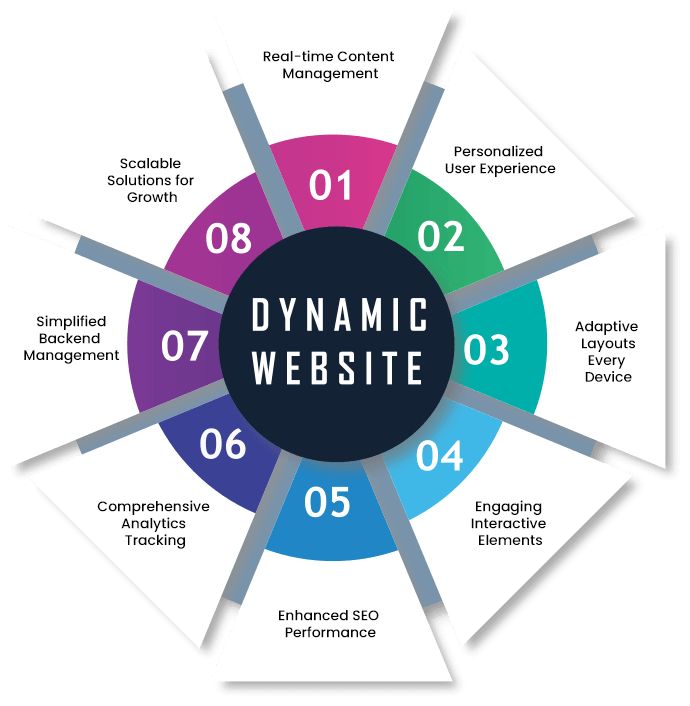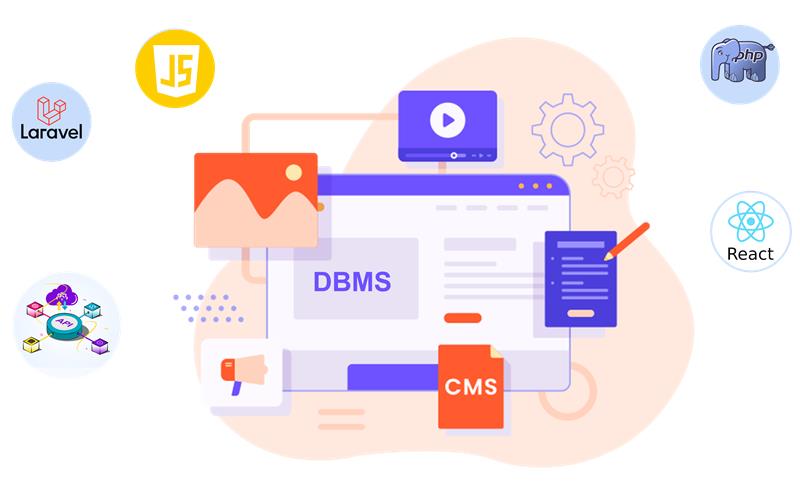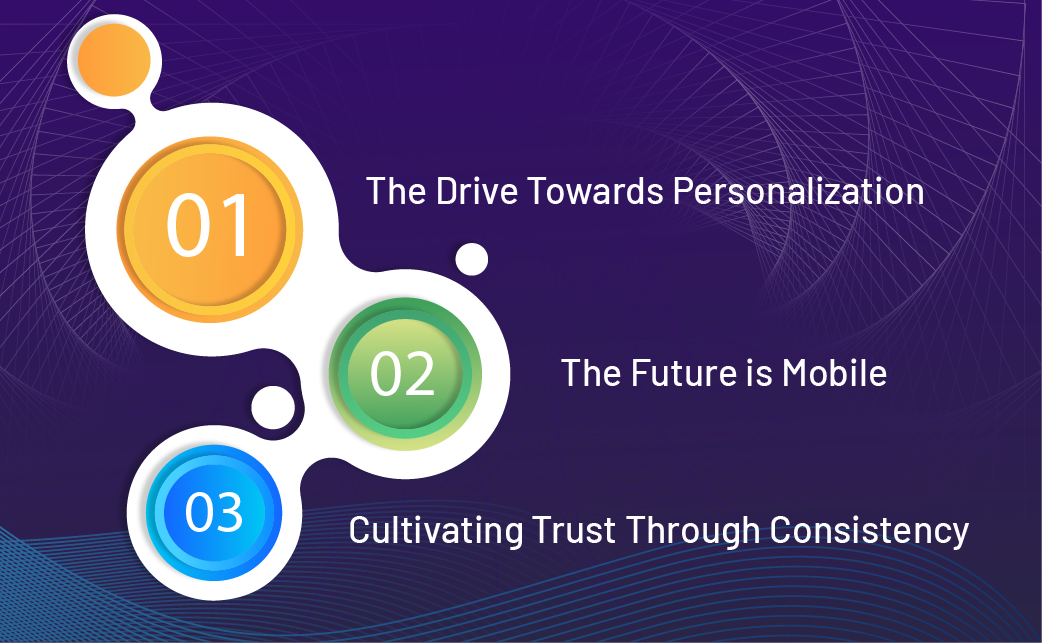In today’s fast-paced digital landscape, where attention spans are shorter than a cat video, Dynamic Website Designing is reshaping how users engage with online content. Gone are the days of static pages that merely served as digital brochures; modern websites are now vibrant, interactive experiences that breathe life into information. The shift towards dynamic designs not only enhances aesthetics but also transforms user interaction, offering tailored experiences that resonate with individual visitors.
Imagine a website that adapts to you in real-time. Whether you’re browsing on a smartphone or desktop, the layout adjusts seamlessly, showcasing responsive web design at its finest. Users are treated to a tailored journey where content is not just static text but a fluid narrative that evolves based on their preferences and behaviors.
One of the standout features of dynamic web development is its ability to provide real-time content updates. Think about it—your favorite food blog can showcase seasonal recipes or trending dish ideas without the need for tedious manual uploads. This level of immediacy creates an engaging and up-to-date browsing experience that keeps users coming back for more!
An important aspect to consider is how these dynamic website features can enhance SEO performance. Search engines favor sites that provide valuable content tailored for users, making your site more discoverable in the vast digital ocean.
This evolution towards dynamic interfaces isn’t simply a trend—it’s a revolution in web design philosophy. By embracing innovative web solutions like dynamic eCommerce platforms or CMS web design, businesses can foster robust user engagement while simplifying backend operations.
“Dynamic websites are the future; they give the power back to users!” - Every forward-thinking web designer ever.If you haven’t yet explored how dynamic website designing can elevate your brand's online presence, it’s high time you did! With these advancements at our fingertips, why settle for anything less than an interactive journey that captivates and converts?
The journey of Dynamic Website Designing has been nothing short of exhilarating, akin to watching your favorite superhero transform from a mere mortal into a powerhouse. This evolution began as businesses realized that static websites were like yesterday’s news—great in their time but quickly overshadowed by something dynamic and engaging.
With the rapid advances in modern web technologies, users today crave more than just a pretty face on a website; they want interaction, personalization, and instant gratification. Enter dynamic designs: the tech-savvy solution that tailors each visitor’s experience in real-time.
Imagine walking into a store where every product seems to cater specifically to you, knowing your preferences—sounds enticing, right? That’s precisely what dynamic websites achieve. By utilizing data analytics to understand user behavior, websites can present information that resonates personally with each visitor. This is not just about aesthetics; it’s about forging an emotional connection that keeps users engaged longer.
This shift towards dynamic website designing isn’t merely about staying relevant; it’s about thriving! Businesses leveraging these capabilities witness enhanced customer satisfaction and loyalty because who doesn’t appreciate being treated like royalty?
The future is bright for those who embrace this trend! As we move further into an era dominated by artificial intelligence and machine learning, expect dynamic website features to become increasingly sophisticated. Imagine AI-driven chatbots providing personalized assistance or content automatically adjusting based on user location—this isn’t science fiction; it's just around the corner!
“The best design is one that you don’t even notice because it serves its purpose so effectively.” - UnknownThis revolution in dynamism calls for brands to rethink their strategies. Dynamic web development opens doors to unexpected opportunities: from engaging storytelling through animated web interfaces to innovative solutions built around user needs.
Your website isn’t just an online address anymore; it’s your brand's digital heartbeat. Embrace dynamic designs and watch as they breathe life into your online presence!
Dynamic web design isn’t just a trend—it’s a treasure chest of features that can dramatically enhance user experience. Let’s take a closer look at the key highlights that make dynamic websites not just functional but also engaging and enjoyable to navigate.
Imagine if every time you visited your favorite site, it felt fresh and new as if it was tailor-made for your visit! With dynamic web design, real-time content updates become a breeze. Whether it’s a latest news article, new product listings, or seasonal promotions, changes can be made instantly without the need for tedious manual uploads. This timely relevance keeps users engaged and coming back for more!
Ever felt like a website was speaking directly to you? That’s the magic of personalized user experiences in dynamic designs! By analyzing user behavior and preferences, these websites can offer customized content that resonates with individual visitors. It's like having a personal shopper who knows your taste and suggests just what you need!
In this mobile-centric world, ensuring that your website looks good on any device is paramount. Dynamic designs excel at responsive web design, providing adaptable layouts that maintain functionality and aesthetics across desktops, tablets, and smartphones. Say goodbye to pinching and zooming; users enjoy seamless experiences no matter how they access your site.
Boredom is the enemy of engagement! To combat this foe, dynamic web design incorporates interactive elements like animations, videos, quizzes, and even gamification features that invite users to interact rather than just passively consume content. This level of interaction can make browsing feel like an adventure instead of a chore!
A well-designed dynamic website doesn’t only look great; it also plays nice with search engines! By offering fresh content regularly and ensuring that users have positive interactions (like low bounce rates), these sites often rank better in search results—making them more discoverable to potential visitors.
“The best websites are those that don’t just inform but engage!” - A savvy digital strategist.Dive deep into user behavior with powerful analytics tools integrated into dynamic web designs. Understanding what users engage with allows businesses to refine their strategies effectively—improving everything from marketing campaigns to overall site functionality based on real data.
No one enjoys grappling with clunky backend systems when updates are due! Dynamic websites often utilize Content Management Systems (CMS) that simplify the process of making changes or adding new content—all while requiring minimal technical knowledge from the admins.
Your website should grow as your business does! Dynamic designs allow for scalability by easily integrating new features or expanding existing ones without overhauling the entire system—leaving room for future innovations.
The world of dynamic website designing is one filled with possibilities where user-centered design takes precedence over everything else. When these features combine harmoniously, they create environments where users feel valued and engaged—a crucial aspect in retaining customers in today's fast-paced digital landscape!

When it comes to dynamic website designing, the real magic happens when a website transforms into a personalized user experience platform. This isn’t just about slapping on a ‘Hello, [User Name]!’ greeting; it’s a sophisticated dance of data and design that makes visitors feel like the site was crafted just for them. Here are some compelling benefits that come along with personalized user experiences:
Imagine logging into your favorite e-commerce site and instantly being greeted with product recommendations based on your previous purchases—like having a personal shopping assistant who knows exactly what you love! By harnessing user data, dynamic websites can deliver content that resonates with individual preferences, significantly enhancing engagement.
In an age where attention spans are shorter than your average TikTok clip, keeping users engaged is crucial. Personalized experiences make users feel recognized, leading to longer session durations as they explore tailored content specific to their needs and interests. It’s the digital equivalent of inviting someone to stay for coffee after an engaging conversation!
When users feel valued and understood, they’re more likely to return. Studies show that personalized experiences can increase customer loyalty by up to 40%. Think of it as building rapport; if your website remembers their favorite products or offers special deals based on past interactions, you’re not just another faceless brand—you become part of their journey!
The ultimate goal for any business is conversions, right? Personalized user experiences can lead to higher conversion rates because they create pathways that guide users towards making decisions—whether that’s signing up for newsletters, downloading apps, or completing purchases. The right content at the right time can be the difference between a mere visit and a loyal customer.
Your dynamic website doesn’t just serve users; it learns from them! By analyzing how visitors interact with personalized features, businesses gain invaluable insights into behaviors and preferences. This data-driven approach helps fine-tune marketing strategies and improve overall site functionality—essentially creating a feedback loop that enhances user satisfaction.
In the crowded online marketplace, standing out is essential. A website that offers personalized experiences sets itself apart from competitors who provide generic content. By adopting dynamically tailored solutions, brands showcase their commitment to understanding consumer needs—a factor increasingly crucial in driving brand loyalty.
No one enjoys playing hide-and-seek while navigating a website! Personalized user experiences streamline navigation by presenting relevant options based on past behavior or preferences, reducing friction and making browsing feel effortless.

The beauty of dynamically designed websites lies in their ability to adapt based on real-time interactions—turning every visit into an experience rather than just another click-through session! As we continue to evolve in this digital age, embracing personalized user experience websites will not only drive engagement but also create meaningful relationships with visitors.
In the realm of dynamic website designing, adaptive website design plays a pivotal role in captivating users and enhancing their overall experience. Imagine visiting a site where the layout morphs seamlessly, adjusting not just to your device but also to your behavior. It’s like having a personal stylist for your browsing needs—tailored to fit your preferences at every turn!

One of the defining features of adaptive website design is its inherent flexibility. Unlike static sites that remain unchanged regardless of who’s visiting, adaptive designs adjust based on several factors, such as device type, screen resolution, and even user location. This multi-faceted approach ensures that whether you’re perched on your couch with a tablet or racing through life on a smartphone, your online experience remains smooth and engaging.
The essence of user engagement lies in creating experiences that resonate personally with visitors. Adaptive designs do just that by leveraging data analytics to inform decisions about what content appears where and when. This targeted approach transforms browsing into an interactive journey rather than a mundane task.
For example, think about an online clothing store that shows you new arrivals based on your previous purchases or favorite styles. The moment you land on their site, clothes in hues you love greet you like old friends! This personalized touch not only captures attention but also keeps users exploring longer—ultimately leading to higher conversion rates.
With mobile usage skyrocketing (it’s practically glued to our hands!), having
a responsive and adaptive website design is no longer optional—it’s vital!
Users expect quick load times, easy navigation, and content formatted perfectly
for their screens.
A study by Google found that 53% of mobile users will abandon
sites that take over three seconds to load—yikes! Adaptive designs help meet these
expectations by ensuring fast performance while maintaining rich visuals.
Your website should feel cohesive whether accessed from a desktop during work
hours or a smartphone while commuting. An integrated adaptive design aids in
crafting this seamless journey across platforms, allowing users to pick up right where
they left off without any hiccups.
This continuity fosters trust—users appreciate
an experience that feels unified instead of disjointed as they transition
between devices.
The takeaway? Emphasizing adaptive website design can significantly enhance user engagement by making every interaction feel personal and relevant. As we move towards increasingly dynamic digital landscapes, embracing adaptability will empower brands to connect meaningfully with their audience.
If there’s one thing we know for sure, it’s this: in the world of web design, flexibility isn’t just an attribute—it’s essential for survival! So why not embrace it and watch user engagement soar?
Dynamic web development is fueled by an array of cutting-edge technologies that work harmoniously to create vibrant and immersive online experiences. The magic happens in the background, where a slew of programming languages, frameworks, and tools come together to deliver the user experiences we often take for granted. Let’s dive into some of the key technologies that are driving this digital revolution.
When it comes to interactive website design, JavaScript is like the conductor of an orchestra—coordinating various elements to create a harmonious performance. This powerful programming language enables developers to implement dynamic features such as animations, real-time updates, and interactive forms. With libraries like React.js and Vue.js making development smoother, JavaScript allows businesses to build responsive websites that feel fluid and engaging.
A solid CMS is essential for managing content efficiently on dynamic websites. Platforms like WordPress, Joomla, and Drupal provide user-friendly interfaces for non-technical users while supporting complex functionalities behind the scenes. This means that businesses can keep their websites fresh with real-time content updates without needing a degree in computer science.
If JavaScript is the star performer on the client-side, then PHP takes center stage on the server side! This scripting language powers dynamic websites by handling data processing and server requests. It’s widely used in conjunction with databases like MySQL to serve up personalized user experiences—think e-commerce sites that remember your last browsing session or social networks that curate feeds based on your interactions.
Dynamic websites thrive on data, making robust database management systems indispensable. Whether it’s MySQL, MongoDB, or PostgreSQL, these systems allow for efficient storage and retrieval of information crucial for delivering relevant content in real-time. Imagine accessing a database-driven website where every click brings up tailored suggestions—it’s all thanks to these behind-the-scenes heroes!
Application Programming Interfaces (APIs) are like digital matchmakers—they enable different software applications to communicate seamlessly with each other! In dynamic web development, APIs facilitate connections between front-end interfaces and back-end servers or third-party services (such as payment gateways or social media platforms). This integration allows sites to pull in live data—keeping content fresh without manual intervention.
The world of web development boasts numerous frameworks designed to streamline processes and enhance productivity. Frameworks such as AngularJS for building complex single-page applications or Bootstrap for creating responsive layouts empower developers to deliver high-quality dynamic web solutions faster than ever before—allowing more time for creativity!
The demand for immediate information has led to innovations such as WebSockets or libraries like Socket.io that allow two-way communication between client and server in real-time. These technologies are pivotal in creating applications where live updates are essential—think chat functionalities on social platforms or notifications about new product arrivals while browsing an e-commerce site.

The future of dynamically designed websites lies not only in these individual technologies but also in how they work together to create cohesive user experiences that delight visitors from all walks of life!
As India continues to embrace its digital revolution, the future of dynamic eCommerce platforms is glowing brighter than ever. With the rapid increase in internet penetration and smartphone usage, online shopping is no longer a luxury but an everyday norm for millions. In this thriving ecosystem, dynamic website designing is poised to be a game-changer, shaping how businesses interact with consumers and driving unparalleled user experiences.
Imagine visiting your favorite online store and being greeted by products curated just for you. It’s like walking into a boutique where every item seems tailor-made! Dynamic eCommerce platforms are harnessing the power of data analytics to create personalized shopping experiences. By analyzing user behavior, preferences, and purchase history, these platforms can suggest items that not only catch the eye but also match users' tastes.
The future of dynamic eCommerce platforms hinges on delivering an impeccable user experience across various devices—be it desktops, tablets, or smartphones. With responsive web design, these sites automatically adjust layouts based on screen size, ensuring that no matter how users access them, they enjoy a uniformly smooth experience.
The advent of AI-driven chatbots is revolutionizing customer service in the eCommerce sector. Imagine having a virtual assistant who is available 24/7 to answer queries or guide you through the purchasing process. These chatbots can provide personalized support by offering recommendations or resolving issues seamlessly:
As environmental concerns grow globally, consumers increasingly favor brands that align with sustainability. Dynamic eCommerce platforms can adapt their offerings based on eco-friendly trends—like promoting sustainable products or offering carbon-offset options during shipping processes. This adaptability not only enhances brand loyalty among environmentally conscious consumers but also positions businesses as leaders in sustainability.
“Dynamic websites aren’t just about aesthetics; they’re about building relationships.” - A wise digital strategist.The potential for dynamic eCommerce platforms in India is boundless—as technology continues to evolve alongside consumer expectations. From smart personalization and seamless navigation across devices to leveraging AI for enhanced customer interaction—the roadmap ahead promises innovation at every turn!
If businesses embrace these advancements through dynamic website designing, they’ll not only meet consumer demands but will thrive amid competition! The future belongs to those who adapt—and in the world of eCommerce, adaptability will redefine success.
As we step into a new era of digital interaction, embracing innovative web solutions in India is not just an option; it's a necessity. With the landscape of dynamic website designing continually evolving, businesses must adapt to stay ahead. This shift isn’t merely about aesthetics; it's about strategizing for user engagement that resonates on a personal level. The potential rewards are immense—improved customer loyalty, enhanced brand visibility, and ultimately, increased sales.
Imagine a vibrant online stage where every visitor's experience feels uniquely tailored to their needs. By implementing responsive web design, websites can transform any device into an engaging portal filled with relevant content and functionalities that captivate users. No more cookie-cutter layouts; instead, think dynamic designs that morph and adjust based on user preferences and behaviors.

In the age of personalization, consumers crave experiences that feel crafted specifically for them. Dynamic websites leverage data analytics to provide tailored recommendations, whether it’s suggesting products based on past interactions or displaying content aligned with user interests. This level of customization fosters deeper connections—akin to having a conversation where every response feels relevant!
The mobile-first mentality permeates every facet of modern web design. With the majority of users accessing sites through mobile devices, ensuring your website provides a seamless experience across all platforms is crucial. Adaptive layouts aren’t just beneficial; they’re essential in a world where browsing habits shift like sand in the wind!
A dynamic website fosters trust by maintaining uniformity across various channels and devices. When users can easily navigate your site without encountering hiccups—whether they're using a tablet at home or their smartphone while commuting—they're far more likely to convert from casual visitors into loyal customers.
“Innovation distinguishes between a leader and a follower.” - Steve JobsThe call is clear: businesses in India must embrace these innovative solutions to thrive in this competitive digital marketplace. By investing in dynamic website features and leveraging cutting-edge technologies, companies position themselves as pioneers in customer engagement.
So as we advance further into this digital age, remember that embracing change isn’t just about keeping up with trends—it’s about staying relevant and creating meaningful connections with your audience. After all, in the grand theater of online interaction, those who adapt will be the stars!
